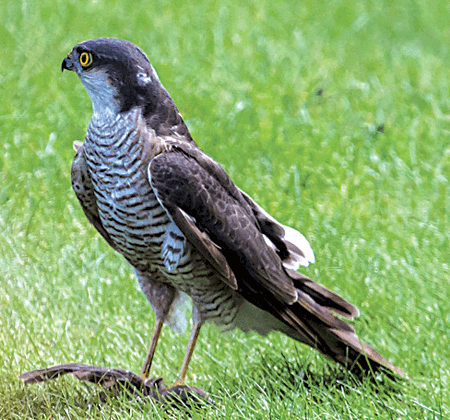GONE ARE SPARROW HAWK AND ENGLISH SPARROW
 Sparrow hawk and English sparrow were common birds when I was a boy. The sparrow hawk was a bird of the country, of open fields, though fields with trees along the edge for it nested in holes, cavities in trees. It was a small bird for a hawk, about the length of a mourning dove, its body about the size of a mourning dove’s though its head was much larger.
Sparrow hawk and English sparrow were common birds when I was a boy. The sparrow hawk was a bird of the country, of open fields, though fields with trees along the edge for it nested in holes, cavities in trees. It was a small bird for a hawk, about the length of a mourning dove, its body about the size of a mourning dove’s though its head was much larger.
A sparrow hawk was a colorful bird, rusty red spotted with black on its back and tail, blue on its wings, also spotted with black. It was blue on the top of its head, white with two black vertical bands on each side of its face. Its wings were pointed, its tail rounded on the end.
Sparrow hawks preyed on small animals of the fields, mice and voles, grasshoppers and crickets and other insects. They hunted by perching on a power line, watching below, launching and plunging on prey they spotted on the ground. They also hunted by hovering, then dropping to the ground. So often were they seen hovering that they were often called windhover birds or just windhovers.
English sparrows were LBJs, little brown jobs. A male was dark brown, striped on the back, dark brown on the sides of its face and back of its neck, had a gray crown, white marked with black on the sides of its face, a black throat and was buffy underneath. A female was brown striped on the back, buffy underneath.
The range of the sparrow hawk was from the East Coast to the West Coast, Florida and Mexico and north into northern Canada, even into southern Alaska in summer. In winter it withdrew from the northern part of its range. Snow determined the northern limit of its winter range. Deep snow hid its prey and made birds in the northern part of its range fly farther south.
The range of the English sparrow was Florida and Mexico and north into northern Canada. It favored the homes of people, cities and towns and farm homes, nesting often in crevices of buildings. It also nested in bluebird houses and the compartments of purple martin houses. It was belligerent enough to drive bluebirds and purple martins out. Throughout its range it was a permanent resident, non-migratory.
Sparrow hawks and English sparrows are still with us but with different names. That’s a good thing in my opinion. If sparrow hawks had preyed on English sparrows, or any kind of sparrow the name would have been appropriate but they rarely caught sparrows or any birds. Well, half of the name would have been appropriate. But it’s not a hawk, it’s a falcon. So the name was changed to kestrel, or American kestrel to distinguish it from a look-alike bird of Europe.
English sparrow was also an inappropriate name. The bird is common not only in England but also throughout most of Europe, Asia and much of Africa. To us it’s an introduced species. The first introduction was eight pairs released in Brooklyn, New York in 1850. More were released in several other locations in the U.S. This is a hardy and prolific bird. A pair will raise two, three, even four broods of four or five young in a season. It multiplied and spread rapidly until it occupied all of North America.
Additionally, the once named English sparrow isn’t a sparrow. True sparrows, song, chipping, white-throated, white-crowned, fox and all the other true sparrows, are birds of North America. This interloper is a weaver finch. But its name wasn’t changed to some kind of weaver finch; it was changed to house sparrow.
Sparrow hawk and English sparrow, common birds when I was a boy. Now they are both gone, in name, and in their place we have kestrel and house sparrow.
- Birds As Weather Forecasters – Life In The Outdoors - December 17, 2021
- Rare Bird Spotted In Indiana – Life In The Outdoors - October 8, 2021
- MY EXPERIENCE WITH DEER – Life In The Outdoors - July 30, 2021


